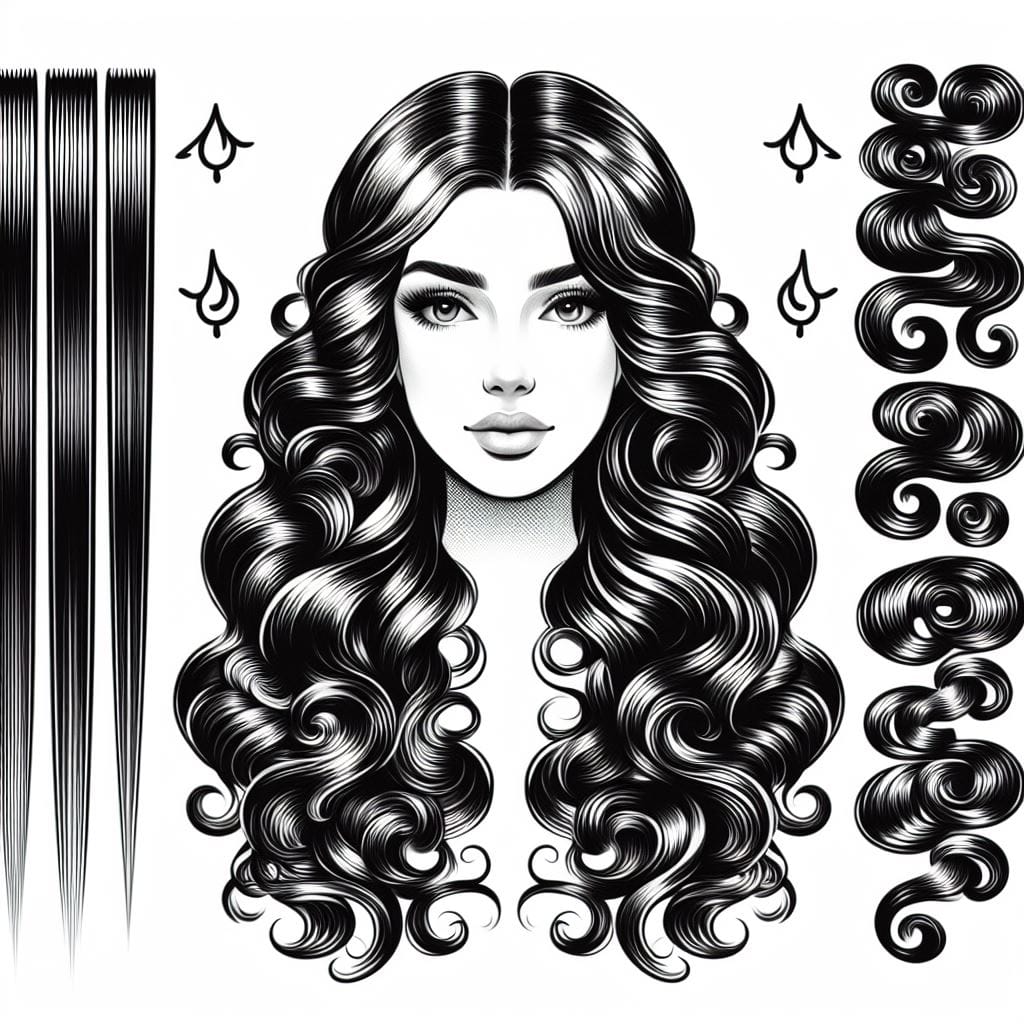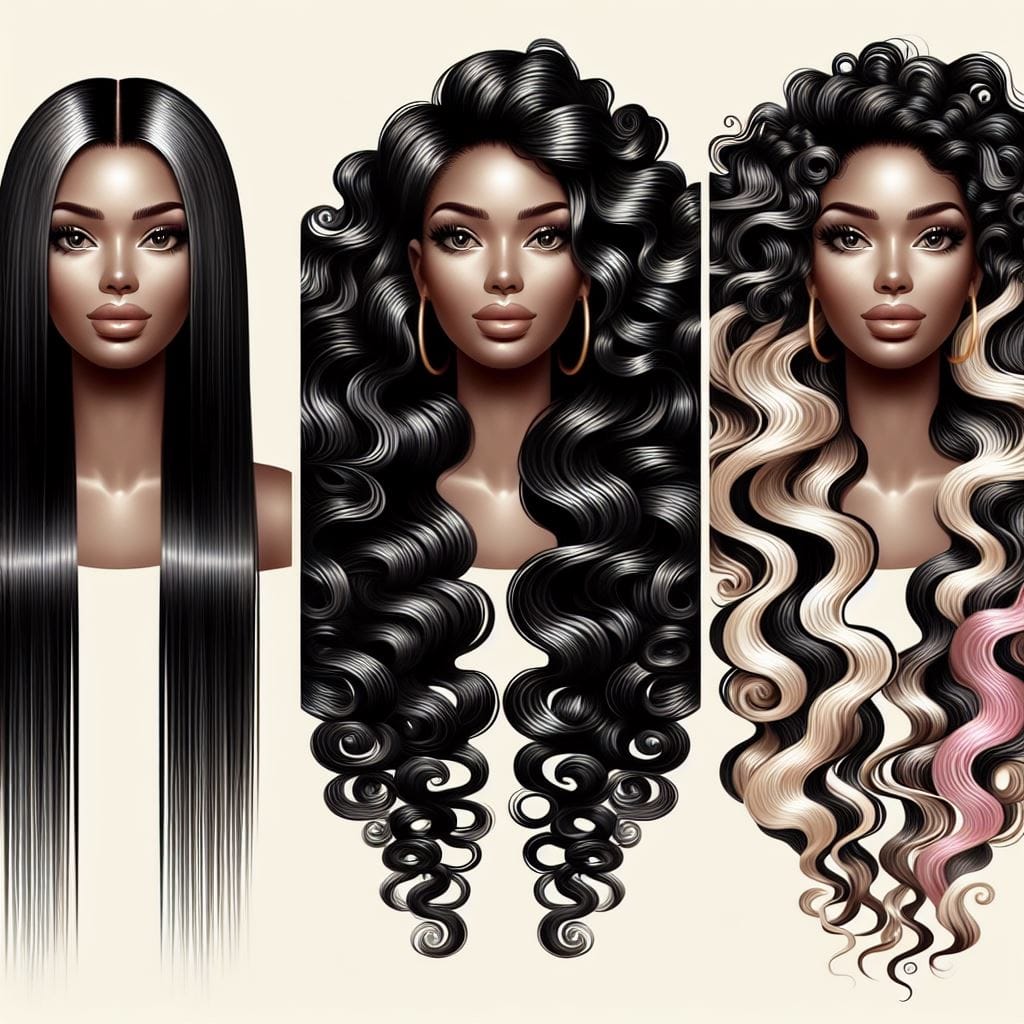Introduction
Welcome to the perplexing world of hair transformations, where the familiar can suddenly become unfamiliar. Have you ever found yourself staring into the mirror, wondering why your once straight locks have morphed into a cascade of curls?
Fear not, for you are not alone in this mysterious phenomenon. In this article, we will delve into the intriguing question: “Why has my straight hair turned curly?” Prepare to embark on a journey through genetics, science, and environmental factors as we unravel the secrets behind this intriguing metamorphosis.
Brief Overview of the Topic
Hair is an incredibly fascinating feature of our bodies that plays a significant role in our self-expression and identity. It comprises three main layers: the cuticle (outermost protective layer), cortex (middle layer responsible for strength and color), and medulla (innermost layer only present in thick hairs).
Within these layers lie countless strands with various textures – straight, wavy, curly, or coily – each unique to its owner. Throughout history, individuals have sought ways to alter their natural hair texture temporarily or permanently through heat styling tools or chemical treatments such as perms or relaxers.
However, what if your hair texture inexplicably changed on its own without any intervention? This puzzling occurrence can happen due to a multitude of factors ranging from hormonal changes and medical conditions to environmental influences.

Personal Anecdotes or Experiences with Hair Transformations
Intriguingly enough, many individuals have experienced firsthand how their once sleek straight tresses gradually transformed into luscious curls over time. Countless anecdotes pepper conversations among friends and family about unexpected shifts in their hair texture.
For instance, Jennifer recalls how her previous poker-straight locks evolved into loose waves during her teenage years. Similarly, Sarah, a mother of two, shares her journey of discovering her hair’s newfound curly nature post-pregnancy.
She was astonished by the ringlets that emerged after the birth of her second child, as her hair had always been naturally straight. These personal stories underscore the reality that hair transformations can occur at any stage in life and can be influenced by various factors.
As we immerse ourselves in understanding why straight hair turns curly, it is crucial to acknowledge these personal anecdotes. They remind us that this topic is not merely an abstract scientific inquiry but one that affects individuals on a deeply personal level, altering their perception of themselves and their overall identity.
Understanding hair structure and types
Before delving into why straight hair may turn curly, it is essential to grasp the fundamentals of hair structure and its various types. The human hair consists of three primary layers: the medulla, cortex, and cuticle. The medulla, which is found in larger hairs, holds a soft core that is often absent in finer strands.
The cortex, which surrounds the medulla or fills the entire hair shaft, contains keratin proteins responsible for strength and elasticity. When it comes to categorizing hair types, we commonly refer to straight, wavy, curly, and coily textures.
Straight hair appears smooth and lacks noticeable bends or waves. Wavy hair displays soft curves that can range from gentle undulations to more defined S-shaped patterns.
Curly hair forms tighter curls or coils with a distinct springiness. On the other hand, coily or kinky hair showcases tightly wound curls or spirals.
The natural texture of one’s locks is mainly determined by genetics and hormones. Our DNA plays a significant role in dictating how our follicles produce and shape each strand of hair.
While some individuals inherit genes for straighter strands with less curling potential, others possess genes that stimulate greater curl formation. Moreover, hormones also impact natural hair type changes over time due to their influence on follicle activity during different life stages.
The Science Behind Straight and Curly Hair
Role of Protein Structure in Determining Hair Texture
The texture of our hair is predominantly determined by the protein structure present within the hair shaft. These proteins, primarily keratin, provide strength, flexibility, and shape to our hair. In straight hair, the protein structure is arranged in a more organized manner, with parallel alignment between the strands.
This results in a smooth appearance and straight texture. On the other hand, curly hair possesses a unique arrangement of these proteins that creates natural bends or curls.
Influence of Keratin on Hair Shape and Curl Pattern
Keratin acts as a critical building block of our hair fibers and has a significant influence on its shape and curl pattern. The specific arrangement of keratin molecules determines how easily water can penetrate the hair shaft. This interaction with water affects hydrogen bonding within the proteins, which consequently alters the shape of individual hairs.
In straight hair, hydrogen bonds are more stable due to their organized alignment. These bonds are relatively stronger, making it harder for water molecules to disrupt them and change the overall shape of the strands.
In contrast, curly hair has more loosely arranged hydrogen bonds that are susceptible to breaking when exposed to moisture. As a result, curly or wavy strands can easily take on new shapes when in contact with water or humidity.
Discussion on the Shape of Follicles and Its Impact on Curliness
Apart from protein structure and keratin influence, another crucial factor determining curliness is follicle shape – specifically its curvature. The shape of follicles varies from person to person due to genetic factors; hence some individuals have more circular follicles while others have oval-shaped ones.
Curly or wavy hair tends to have more oval-shaped follicles compared to those with straight hair who often possess circular-shaped follicles. The shape of the follicles affects the angle at which hair emerges from the scalp.
Oval-shaped follicles, present in individuals with curly hair, produce strands that grow at a sharper angle, leading to more pronounced curls or waves in the hair texture. In contrast, straight hair usually emerges from circular-shaped follicles with a more perpendicular trajectory to the scalp.
Understanding these scientific aspects sheds light on why some individuals experience transformations in their hair texture, transitioning from straight to curly. While genetics and hormones play a significant role in determining natural hair type, environmental factors, and external treatments can also influence these changes.
IV. Environmental factors affecting hair texture change
Humidity and its effect on hydrogen bonds in the hair shaft
Humidity plays a significant role in transforming straight hair into curls. This phenomenon occurs due to the unique structure of the hair shaft, which consists of hydrogen bonds that can be easily influenced by moisture in the air. When exposed to high humidity levels, straight hair tends to absorb moisture from its surroundings.
As a result, the hydrogen bonds within the hair shaft absorb this moisture, causing them to temporarily loosen and reshape. This alteration causes the typically straight strands to become wavy or curly.
Heat styling tools and their impact on temporary curl formation
Heat styling tools are another environmental factor that can lead to temporary changes in hair texture, specifically through curl formation. These tools include curling irons, hot rollers, and straighteners.
When heat is applied to the hair shaft using these tools, it affects the hydrogen bonds present within it. The heat disrupts these bonds by temporarily breaking them down or rearranging their structure.
Explanation of how heat alters hydrogen bonds temporarily
Heat-induced curl formation works by altering the hydrogen bond pattern within each strand of hair temporarily. The heat weakens these bonds, allowing for reshaping of the hair shaft as it cools down and forms new temporary curls or waves based on how it is manipulated during this transition period.
The role of moisture in heat-induced curls
Moisture also plays a crucial role in heat-induced curls. To achieve temporary curl formation through heat styling tools effectively, it is essential to ensure that there is enough moisture present within each strand before applying heat.
Moisture acts as a catalyst during this process by making sure that hydrogen bonds are malleable enough for reshaping when subjected to high temperatures. By understanding how humidity affects hydrogen bonds and how heat styling tools can temporarily alter hair texture, individuals can better comprehend the environmental factors contributing to their straight hair turning curly.
The role of moisture in this process further emphasizes the significance of proper hair hydration when attempting to achieve desired curls using heat styling tools. It is essential to remember that these changes in hair texture are temporary and reversible, offering individuals the freedom to experiment with different looks while maintaining the option to revert to their original hair type.
Hormonal changes and their influence on hair texture
Puberty and its effect on sebum production leading to textural changes
During the tumultuous phase of puberty, marked by significant hormonal fluctuations, it is not uncommon for individuals to witness unexpected changes in their hair texture. One of the key factors contributing to this transformation is the surge in sebum production. Sebaceous glands, which are attached to hair follicles, become hyperactive during this period under the influence of androgens – the male hormones present in both males and females.
The excessive secretion of sebum can have a profound impact on hair texture, making it appear greasier or more prone to becoming oily. In some cases, this excess oiliness can lead to a change in hair structure, resulting in waves or curls where none existed before.
Pregnancy-related hormonal shifts causing temporary curliness
Pregnancy is a remarkable journey that brings about numerous physical changes within a woman’s body, and unexpectedly altering hair texture can be one such transformation. Hormonal fluctuations play a crucial role during pregnancy, especially with increased levels of estrogen and progesterone. These hormones are responsible for promoting blood flow to the scalp and stimulating hair growth.
Additionally, elevated levels of estrogen may affect the anagen (growth) phase of the hair cycle, resulting in reduced shedding. This accumulation of growing hairs combined with increased moisture retention leads many women to experience temporary curliness during pregnancy.
Menopause and its potential impact on permanent curl formation
As women approach menopause – that natural stage marking the end of reproductive years – they undergo significant hormonal shifts. The decline in estrogen levels leads to various physiological alterations throughout the body, including changes in hair texture. With reduced estrogen circulating within their system, women may notice a gradual loss of elasticity and moisture from their strands.
This loss of moisture can cause the hair to become drier, brittle, and more susceptible to breakage. Furthermore, the reduction in estrogen allows other hormones, such as androgens, to exert a more prominent influence.
These androgens can trigger changes in the hair follicles, leading to a permanent alteration in hair texture – including the emergence of curls or waves where straight hair once prevailed. Overall, hormonal changes play a significant role in modifying hair texture throughout various stages of life.
Whether it’s the sebum surge during puberty or the hormonal fluctuations experienced during pregnancy and menopause, these shifts can have a profound impact on our locks. Understanding these influences not only helps us appreciate the remarkable adaptability of our bodies but also enables us to embrace and care for our ever-evolving tresses with grace and confidence.
Medical conditions associated with curly transformation
Polycystic Ovary Syndrome (PCOS) is a possible cause of curly hair
Subtitle: The intricate link between hormones and hair Polycystic Ovary Syndrome (PCOS) is a complex hormonal disorder that affects millions of women worldwide.
One of the lesser-known manifestations of PCOS is its potential impact on hair texture, which can lead to the transformation of straight hair into curly locks. PCOS disrupts the normal balance of hormones in a woman’s body, particularly increasing androgen levels.
Androgens are typically considered “male” hormones, but women also produce them in smaller amounts. Elevated levels of androgens can stimulate the sebaceous glands in the scalp, leading to increased oil production and subsequent changes in hair texture.
The exact mechanisms through which PCOS causes straight hair to turn curly are not fully understood. However, it is believed that increased androgen levels may influence the shape and size of the hair follicles.
Androgens can bind to receptors on these follicles, altering their structure and leading to textural changes such as curliness or waviness. Additionally, hormonal imbalances associated with PCOS can affect protein synthesis in the hair shafts, resulting in changes to their overall shape.
Thyroid disorders affecting hormone levels leading to textural changes
Subtitle: The Thyroid’s Role in Tresses The thyroid gland plays a crucial role in regulating various bodily processes by producing essential hormones. When this gland malfunctions due to disorders such as hypothyroidism or hyperthyroidism, it can have a profound impact on not only our metabolism but also our physical appearance – including our hair texture.
Thyroid disorders disrupt hormone production and release, which affects various tissues throughout the body. In cases where an individual experiences hypothyroidism (underactive thyroid), the reduced levels of thyroid hormones can lead to dryness and brittleness in the hair, resulting in a loss of natural moisture.
This reduction in moisture levels can cause previously straight hair to become frizzy and curly due to increased susceptibility to environmental humidity. On the other hand, hyperthyroidism (overactive thyroid) can cause an acceleration of metabolic processes, including those related to hair growth.
Consequently, individuals with hyperthyroidism may notice changes in their hair texture, including increased curliness or waviness. It is worth noting that while thyroid disorders can contribute to changes in hair texture, they seldom cause a complete transformation from straight to curly.
However, these conditions can exacerbate pre-existing tendencies towards curliness or trigger noticeable alterations in the texture of an individual’s hair. Medical conditions such as Polycystic Ovary Syndrome (PCOS) and thyroid disorders have been linked to changes in hair texture.
PCOS affects hormone levels and influences follicle structure, potentially causing straight hair to turn curly. Meanwhile, disruptions in thyroid hormone production due to various disorders can lead to dryness or excessive moisture retention in the hair shafts – resulting in frizzier or curlier tresses.
While these conditions may not solely cause a complete transformation from straight to curly, they undoubtedly contribute significantly to altering one’s natural hair texture. Understanding these medical associations enhances our knowledge of how our bodies function holistically and emphasize the intricate connections between internal health and external appearances like our crowning glory – our cherished locks!
Chemical treatments’ role in altering natural texture
Perms or relaxers as options for permanent texture change
Undergoing a chemical treatment such as a perm or a relaxer can dramatically transform one’s natural hair texture. A perm, short for permanent wave, is a process that creates curls by breaking down the hair’s protein structure through the use of chemicals.
The first step involves applying a waving solution consisting of ammonium thioglycolate or similar compounds to soften the hair and make it more pliable. This solution breaks the disulfide bonds within the hair shaft, reshaping it into curls using rods or rollers according to the desired curl size.
Once set, another chemical solution called a neutralizer is applied to reform new disulfide bonds and lock in the curls. On the other hand, relaxers are chemical treatments specifically designed to straighten curly or oily hair permanently.
Relaxers contain alkaline substances like sodium hydroxide or calcium hydroxide that break down protein bonds within each strand. These chemicals alter the structure of the hair shaft, making it straighter by disrupting its natural curl pattern.
The relaxer is carefully applied to ensure even distribution and left on for a specific duration determined by individual hair type and desired result. Afterward, the hair is thoroughly rinsed and neutralized with an acidic solution to stabilize pH levels and prevent further processing.
Explanation of how perms work to create curls
When undergoing a perm, ammonium thioglycolate acts as a reducing agent that breaks down cysteine amino acid chains in keratin proteins found in our hair strands through a process known as reduction reaction. This allows new bonds to form between sulfur atoms within keratin molecules which creates disulfide bridges with adjacent strands of keratin proteins nearby.
As these new connections are formed while the hair is wrapped around rods or rollers, the hair takes on a curly shape. The size and type of perm rods used, as well as the wrapping technique, determine the resulting curl pattern.
Insight into relaxers’ process to straight
Relaxers are alkaline solutions that contain sodium hydroxide or calcium hydroxide. These chemicals work by penetrating the hair shaft and breaking down the protein structure, specifically disrupting disulfide bonds in keratin proteins. Sodium hydroxide-based relaxers have a higher pH level than calcium hydroxide relaxers and are more commonly used due to their stronger relaxing effect.
The chemicals in relaxers act as softeners, ultimately changing the hair’s texture from curly or coil to straight. After applying the relaxer evenly to the hair, it is left on for a specific amount of time depending on factors such as hair type and desired result.
This time is crucial because leaving it on for too long can lead to damage or over-processing. Conclusion: Chemical treatments like perms and relaxers provide individuals with options for permanent texture change by altering the protein structure of their hair strands.
Perms create curls through a process involving chemical reduction and reformation of disulfide bonds within keratin proteins, resulting in new curl patterns determined by rod size and wrapping technique. Relaxers use alkaline substances to break down protein bonds within each strand, effectively straightening curly or oily hair permanently.
Understanding these processes empowers individuals to make informed decisions about altering their natural texture while considering potential risks and benefits associated with chemical treatments. Embracing our ever-evolving beauty preferences can bring newfound confidence and self-expression while celebrating diverse hairstyles.

